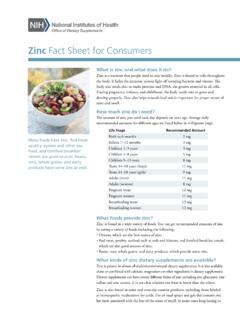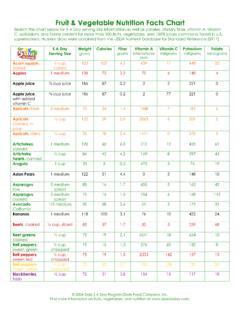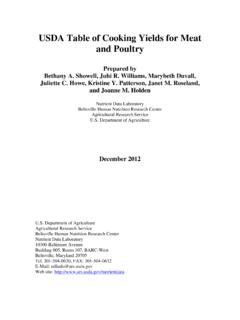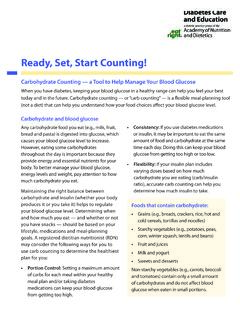Transcription of BASIC NUTRITION WORKBOOK
1 WORKBOOKBASIC NUTRITION1-1 WorkbookAbout the BASIC NUTRITION WorkbookThis WORKBOOK contains activities and test questions that pertain to information in the BASIC NUTRITION Module as well as some key reference tables. This WORKBOOK is your personal copy to use and keep. Feel free to write in it and use it to record your answers to the activities and test activities will ask you to provide personal information like personal dietary intake, weight, family history, etc. These are designed to help you create personal health goals, so be honest. No one will see this information but you. Using this WORKBOOK Along with the BASIC NUTRITION ModuleAs you read through the main text of the BASIC NUTRITION Module icons will prompt you to stop and refer to the corresponding activities and test questions in this WORKBOOK . Activities The activities in this WORKBOOK will enhance your learning and help you apply the information in the module. Test Questions This WORKBOOK contains six sets of test questions that relate to information in the six parts of the your final test answers on the answer sheets following this page of the WORKBOOK .
2 The answer sheets can be removed from the WORKBOOK if you need to submit them to a supervisor. Each local agency has different procedures for checking test answers and making corrections. Check with your supervisor to find out the procedure in your clinic. BASIC NUTRITION Workbook1-2 WorkbookThings You Will Need to Complete the WORKBOOK Activities: Computer with Internet access Calculator Your current height and weight measurements Measuring tape Information about your family health history (if available)1-3 WorkbookAnswer Sheets(Use these pages to mark your final answers to the test questions.)Name:_____Answer Sheet: Part 1 Test 1. TRUE FALSE2. TRUE FALSE3. TRUE FALSE4. A B C D E5. A B C D 6. A B C D7. A B C D E 1-4 WorkbookName:_____Answer Sheet: Part 2 Test1. A B C D 2. TRUE FALSE3 Age Gender Medical conditions Marital Status Hair Color Weight4. A B C D 5.
3 A B C D 6. TRUE FALSE7. TRUE FALSE8. TRUE FALSE1-5 WorkbookName:_____ Answer Sheet: Part 3 Test 1. Energy drinks Plain milk Apple pie Bananas Fruit punch Ice cream2. TRUE FALSE 3. TRUE FALSE4. TRUE FALSE 5. Shortening Salmon Partially-hydrogenated vegetable oil Whole milk Avocado 6. TRUE FALSE7. TRUE FALSE8. TRUE FALSE 9. Tomato Egg Beef Peanut butter Olive oil10. TRUE FALSE11. TRUE FALSE12. TRUE FALSE1-6 WorkbookName:_____Answer Sheet: Part 4 Test1. TRUE FALSE2. TRUE FALSE3. TRUE FALSE4. A B C D 5. A B C D 6. A B C D 7. Spinach Coffee Fortified breakfast cereal Black-eyed peas Asparagus Milk Cream Cheese8. Yogurt Chicken Canned Salmon with edible bones Pork Mozzarella cheese Calcium-fortified orange juice Tea Milk9. A B C D 10. A B C D 1-7 WorkbookName:_____Answer Sheet: Part 5 Test1.
4 Regular soda Apple Doughnut Brown rice Pinto beans Candy2. A B C D 3. A B C D 4. A B C D 5. A B C D 6. A B C D 7. Eating your lunch in the car on your way into work. Turning off your cell phone during dinner. Watching TV while eating chips out of a bag. Taking time to eat meals A B C D 1-8 WorkbookName:_____Answer Sheet: Part 6 Test1. TRUE FALSE2. TRUE FALSE3. TRUE FALSE4. TRUE FALSE5. TRUE FALSE6. TRUE FALSE7. TRUE FALSE8. A B C D9. High blood pressure High cholesterol and triglycerides High blood glucose Family history of chronic disease Tobacco use (Note: there are no activities for Part 1)1-9 WorkbookPart 1 Test (Record your final answers on the answer sheets in the front of this WORKBOOK .)1. TRUE FALSE Poor diet and physical inactivity may soon overtake tobacco use as the leading preventable cause of death. 2. TRUE FALSE Most Americans are physically active on a regular basis.
5 3. TRUE FALSE Common sources of calories among children in the are grain-based desserts, pizza, and high-sugar drinks like sodas and energy Check the factors that have contributed to obesity and overweight among Americans. A. Larger portion sizes. B. Not enough physical activity. C. More convenience foods in grocery stores. D. Less cooking at home. E. All of the Complete the following sentence by checking all that apply. food insecurity A. Is not related to income. B. Means not having enough money or other resources to get food throughout the year. C. Is not a concern in the United States. D. All of the Complete the following sentence by checking all that apply. A food desert is an area where A. People don t have reasonable access to healthy foods. B. Farmers grow food crops under very hot and dry conditions. C. There is an abundant supply of edible cacti and succulents. D. None of the As a WIC staff member, you can A.
6 Help participants become more food secure each month. B. Help clients understand the benefits of breastfeeding. C. Help WIC families learn how their diet and physical activity choices can affect their health in the long run. D. Use this module to help make healthy changes in your own lifestyle. E. All of the Using the usda nutrient database How Much NUTRITION is in 1 Medium Carrot?1. Click on the link for usda s National nutrient database for Standard Reference ( ).2. Click "Start Your Search Here" and type "carrot" into the search Click on Carrots, raw. 4. The next window lists different descriptions of raw carrots (whole, grated, chopped, etc.). You can enter specific amounts. For example, you can get nutrient values for 3 medium carrots, cup of grated carrots, or 56 grams of carrots. 5. The results provide a detailed list of all the nutrients in medium carrots. If you were successful, the results should show you that 1 medium carrot has 25 calories (kcal) of energy, grams of dietary fiber, and plenty of other nutrients!
7 6. Try one more on your own: How many milligrams of vitamin C are in cup of chopped raw broccoli? (Answer: mg)1-12 WorkbookActivity Keep a One-Day food Record: For this activity write down all the foods that you eat and drink in a typical 24-hour period, including the amounts. Use the form on the following page to record everything (make copies if needed), or create your own form. Start today if possible. Here are some tips: Stick to your usual intake so that your record reflects a typical day. If today is an unusual day in terms of the foods you eat, start your food record tomorrow. Write down everything you eat throughout the day. Include the milk and sugar you put in your coffee, the water you drink, any food samples you try at the store, etc. Keep your food record with you wherever you go. Be specific when describing the food . For example, write down whole-wheat bread rather than just bread. Write baked chicken drumstick, instead of just chicken.
8 For mixed dishes like casseroles, pizza, sandwiches, etc., make a note of the various ingredients, toppings, etc. The form is there for you use it however it best suits you. Try to be fairly accurate about amounts. If you aren t sure how much cereal you eat, pour it into the bowl you usually use, then take it out and measure the amount. The more accurate you are about amounts, the more you ll learn about your own nutrient intake and food you finish your food record keep it handy. You won t need to do a complete analysis of your nutrient intake for this activity, but later in the module you will refer to your food record to see how some of your usual food choices measure up in terms of nutrients. Note: To keep this food -record activity simple we ve asked you to track just a single day. But keep in mind a single day doesn t tell the whole story. What really matters are the nutrients you get over the course of several days. 1-13 WorkbookOne-Day food RecordName: _____ Date: _____TimeFood Amount and DescriptionOther Notes 1-14 WorkbookPart 2 Test (Record your final answers on the answer sheets in the front of this WORKBOOK .)
9 1. Which of the following nutrients provide calories? A. Carbohydrates B. Fats C. Protein D. All of the above2. TRUE FALSE One teaspoon of sugar has more calories than one teaspoon of Which items influence a person s nutrient needs? (Check all that apply.) Age Medical Conditions Hair Color Gender Marital Status WeightUse this NUTRITION Facts Label for questions 4-6(Source: ) NUTRITION FactsServing Size 1 cup (228g)Servings Per Container 2 Amount Per ServingCalories 250 Calories from Fat 110 % Daily ValueTotal Fat 12g 18% Saturated Fat 3g 15% Trans Fat 3gCholesterol 30mgSodium 470mg 20%Total Carbohydrate 31g 10% dietary Fiber 0g 0% Sugars 5gProtein 5g Vitamin A 4%Vitamin C 2%Calcium 20%Iron 4% *Percent Daily Values are based on 2,000 calories diet. Your Daily Values may be higher or lower depending on your calories needs.
10 Calories 2,000 2,500 Total Fat Less than 65g 80g Sat Fat Less than 20g 25gCholesterol Less than 300mg 300mgSodium Less than 2,400mg 2,400mgTotal Carbohydrate 300g 375g dietary Fiber 25g 30g1-15 Workbook4. How many calories are in one serving of this food ? A. 110 B. 250 C. 470 D. 5005. How many calories would you be eating if you consumed the entire package of this food ? A. 110 B. 250 C. 470 D. 5006. TRUE FALSE This food is high in calcium. 7. TRUE FALSE This food is high in TRUE FALSE One serving of this food has 18 grams of fat. 1-16 WorkbookActivity Added Sugars Reality healthy is a matter of balance and moderation. A healthy diet can include added sugars but if you are always reaching for candy and cookies instead of healthier snacks that s a problem. If you are trying to eat fewer calories, cutting back on simple sugars will help. Look at your one-day food record and circle at least two foods that you know are high in added sugars.














